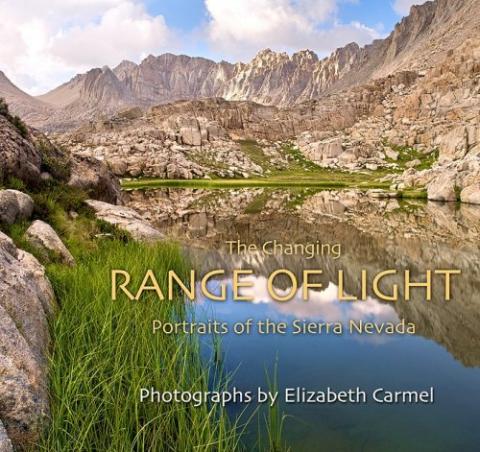As sunrise washes the High Sierra of Yosemite National Park with its rays, it flares the landscape, highlighting peaks such as Cathedral and Tuolumne and Mount Hoffman. Shadows that blanketed the lakes and Tuolumne River slowly lift, bringing the high country to life.
Photographer Elizabeth Carmel captures just such a setting in her gorgeous new book, The Changing Range of Light, Portraits of the Sierra Nevada. There on page 86 the sunrise glints off the park's granitic peaks in the background, while in the foreground the Tuolumne River sweeps through its namesake meadows.
Sunset, too, is at play in Ms. Carmel's book, for 11 pages earlier the day's last rays ignite not only the Palisade Range in Kings Canyon National Park but also fire rainbows.
Through 61 plates -- culled from roughly 3,000 photographs -- the photographer frames the varying moods and temperaments of the High Sierra, both within Yosemite, Sequoia, and Kings Canyon national parks and those found in their neighboring lands. Sweeping ridgelines, reflective lakes, and closeups of forest and meadow vegetation come across in exquisite detail, thanks both to Ms. Carmel's eye and the ultra-high resolution 39-megapixel digital camera she wields.
If you ever wondered if you should visit the Sierra parks, this book will convince you in a minute.
But there is more to gorgeous photography on display. There is change, subtle in most cases, affecting the landscape. An example of that change is explained in the few sentences of foot-noted text that accompany the portrait of sunrise in Tuolumne Meadows on page 86.
Between 1914 and 1920, zoologist Joseph Grinnell and colleagues surveyed a transect across Yosemite National Park, documenting in great detail the diversity and distribution of terrestrial vertebrates. Recently a team of biologists resurveyed the same sites, and documented the changes in populations of small mammals. They found upward shifts (500m on average) of the upper elevational limits of half of the 28 species monitored. Formerly low-elevation species expanded their ranges and high-elevation species contracted theirs. The latter group included the alpine chipmunk (Tamais alpinus), Belding's ground squirel (Spermophilus beldingi), water shrew (Sorex palustris) and pika (Ochotona princeps).
Written by two climate-change scientists, Drs. Robert Coats and Geoffrey Schladow, the short boxes of text that accompany the photography provide additional heft and meaning to Ms. Carmel's work. Whether you believe anthropogenic factors are influencing the changing climate is almost secondary to the acceptance that the climate is changing. It's likely not everyone will approve of the melding of spectacular High Sierra settings with text that concerns climate change, and Ms. Carmel understands that. Yet she hopes nevertheless they'll come to the book with an open mind.
"The reason I wanted to include scientific data with extensive footnotes is to give anyone who is skeptical the opportunity to review the underlying research themselves. Climate change really is an 'inconvenient' truth - wishing it were not so or denying it with no scientific basis will not change the dramatic effects this issue will have on our planet and civilizations," she says. "There is an urgency to adapt; at this point we are beyond being able to prevent the changes that will occur."
By venturing into the High Sierra, her backyard, for a book that intertwines the "Range of Light," as John Muir called the Sierra, with climate-change science the photographer hopes to bring greater awareness to the fact that climate change is not only affecting far off places like the Arctic.
"As a photographer who lives and works in the Sierra I wanted to bring attention to the issue, particularly among a non-scientific audience that may not be aware that climate change is affecting our local landscapes, not just the ones in the arctic regions," says Ms. Carmel, who spent four years assembling the photography. "I also think that landscape photographers have a long history of using their work to help raise awareness of environmental issues, so I wanted to carry on that important legacy. "
The photos themselves are not presented as examples of impacts wrought by climate change. Rather, they "more represent specific moments in time that show a landscape that will likely appear very different for future generations," she says.
"I did make a special effort to get the image of the Palisade Glacier (p.83), since that is an area that is undergoing dramatic change as the glaciers disappear over time," says the photographer. "Also, the image of the pikas' leaf harvest and pika den (p. 85) I think is very poignant, since pikas are under great stress in the Sierra from the warming climate. I'm not sure if a photographer 50 or 100 years from now will be able to capture such an image."
Most of the text by Drs. Coats and Schladow was compiled after Ms. Carmel presented them with her images. However, at their suggestion she made that extra effort to capture Palisade Glacier, the pika den, a bristlecone forest (p. 81) and Tuolumne Meadows due to how climate change is impacting those subjects.
You can obtain a signed copy of this 12-inch by 12-inch hardcover edition by contacting www.HawksPeakPublishing.com.








Comments
I'm looking forward to seeing -- and perhaps purchasing the book.
And as one living in Utah where many of my neighbors have simply dismissed the possibility of climate change as yet another Communist plot being pushed by our current administration, I hope this book will indeed help open at least a few minds to the extremely unlikely (in their minds, at least) possibility that it is not.
(Oh, Yeouch! Captcha is back . . . . .)